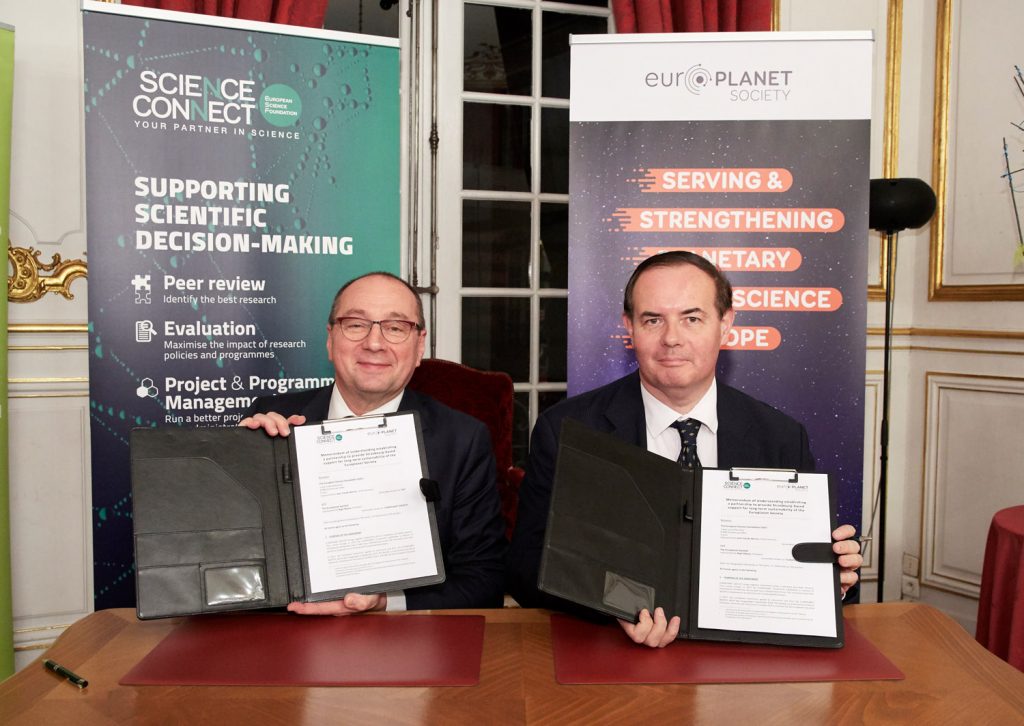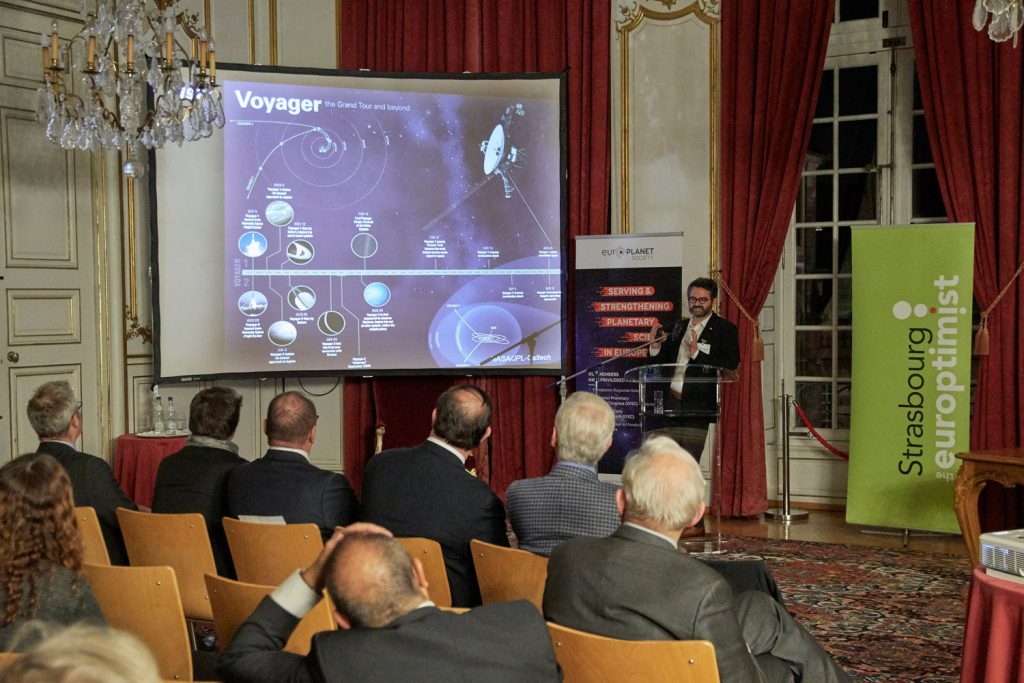European Science Foundation signs agreement to host the Europlanet Society in Strasbourg
The Europlanet Society was formally established yesterday at an official event in the City Hall of Strasbourg following the announcement made at the European Planetary Science Congress (EPSC) 2018 in Berlin. The Europlanet Society is a new membership organisation that aims to promote the advancement of planetary science in Europe and builds on the heritage of 15 years of Europlanet projects funded by the European Commission. The Society is open to both corporate and individual members.
At the event, the Europlanet Society and the European Science Foundation (ESF) signed a Memorandum of Understanding to seal their partnership and strengthen their collaboration in the field of planetary science. Henceforth the ESF will host the Executive Office of the Society in its headquarters in Strasbourg and oversee the day-to-day running of the Society.
Jean-Claude Worms, ESF Chief Executive, said “Since its establishment in 1974 the ESF has always been a strong supporter of astronomy and space science, by hosting the European Space Science Committee (ESSC) that had been created earlier that year under the auspices of the UK Royal Society, or creating the ESF’s Astronomy Standing Committee. Soon after, the ESF-ESSC and the US National Academies’ Space Science Board organized a series of joint workshops in Strasbourg and Heidelberg in 1980, 1982 and 1984, that shaped the way for the development of the major planetary science missions Cassini and Rosetta. I am particularly proud that ESF can continue today to actively support that community through the hosting of the Europlanet Society in our Headquarters in Strasbourg”.

“The launch of the Europlanet Society is a landmark moment in the development of European planetary Science community and recognises that Europe is a major player in space exploration both in our solar system and beyond. The Europlanet Society aims to build and foster the European planetary Science community (academic and industrial) and engaging Europe’s citizens with this inspirational area of international research” said Prof Nigel Mason, President of the Europlanet Society.
The Europlanet Society will engage with decision makers and solicit the views of its members to provide coordinated input into strategy papers and policy consultations. Within Europe , the Europlanet Society will serve as a means of bringing the planetary science community together and contributing to the further development of the field, as well as building collaborations with related organisations in Europe and worldwide. These collaborations were represented at the event by Prof Michael Bode, Special Representative of the European Astronomical Society to the European Union. In his speech he emphasized the importance of scientific societies in building communities the European Research Area.
A scientific address was contributed by keynote lecturer, Dr Gabriel Tobie, who as a CNRS Researcher at the University of Nantes investigates the geophysical and geodynamic processes in oceans. On this occasion, he gave a presentation on Icy moons of the Solar System and their potential for hosting life.

The Europlanet Society is overseen by an elected Executive Board and ten European Regional Hubs will help the Society to develop planetary science communities and networks at a regional and national level. The Society has also established committees to support diversity and early career researchers within the community. Additional working groups will develop links with industry, amateur astronomers, outreach and education providers, and policy makers.
Science Contacts
Nigel Mason
President of the Europlanet Society
nigel.mason@open.ac.uk
Emmanouil Detsis
Europlanet Society Executive Office
European Science Foundation
edetsis@esf.org
Media Contacts
Anita Heward
Europlanet/EPSC Communications Officer
anita.heward@europlanet-eu.org
Laura Alvarez
ESF Communications Officer
Europlanet Society Executive Office
media@europlanet-society.org
Notes for Editors
European Science Foundation
The European Science Foundation (ESF) was established in 1974 as an independent, non-governmental, non-profit organization committed to promoting the highest quality science in Europe, and to driving progress in research and innovation. Through Science Connect, its Expert Services division, the ESF provides quality scientific support based on a deep understanding of the scientific landscape, funding context and needs of the research community. With a portfolio of 31 high-profile European Commission funded projects since 2003, the ESF offers its expertise in project coordination and support to its members, customers and partners. It is also at the leading age of grant evaluation, with 4,500 research proposals evaluated since 2014, and a strong community of international experts that guarantee independence and transparency in the assessment process.
More information at www.esf.org
Europlanet Society
The Europlanet Society is a membership organisation which actively promotes the advancement of planetary science and related fields in Europe. The Society is open to individual and corporate members and builds on the heritage of 15 years of Europlanet projects funded by the European Commission. The Europlanet Society organises the annual European Planetary Science Congress (EPSC), the largest annual meeting on planetary science in Europe.
More information at www.europlanet-society.org
Europlanet
Since 2005, the Europlanet project has provided European’s planetary science community with a platform to exchange ideas and personnel, share research tools, data and facilities, define key science goals for the future and engage stakeholders, policy makers and European Citizens with planetary science.
The Europlanet 2020 Research Infrastructure (RI) is a €9.95 million project to address key scientific and technological challenges facing modern planetary science by providing open access to state-of-the-art data, models and facilities across the European Research Area. The project was launched on 1st September 2015 and has received funding from the European Union’s Horizon 2020 research and innovation programme under grant agreement No 654208. Europlanet 2020 RI is led by the Open University, UK, and has 33 beneficiary institutions from 19 European countries.
More information at www.europlanet-2020-ri.eu


























































